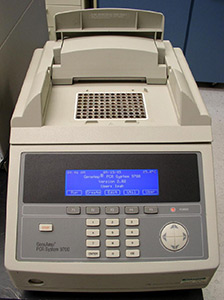Archival Notice
This is an archive page that is no longer being updated. It may contain outdated information and links may no longer function as originally intended.
Home | Glossary | Resources | Help | Contact Us | Course Map
Thermal Cyclers
A thermal cycler heats and cools a DNA sample in order to perform the PCR. There are numerous thermal cyclers available from a variety of manufacturers. The instruments vary in the number of samples that can be handled, the size of reaction tube used, the speed of temperature change, and the cost.
Thermal cyclers provided by Applied Biosystems have been the most widely used in the forensic community. Their model 480 was one of the first to be used in forensic DNA analysis, but it did not come with a heated lid. The process using the 480 required sample reaction mixtures to have an overlay with a drop of mineral oil in order to prevent evaporation. Later models such as the GeneAmp® PCR systems 2400 and 9600 have heated lids, but they have also been discontinued. (Note: some forensic laboratories still use them).
Currently, one of the most popular thermal cyclers in forensic science laboratories is the Applied Biosystems GeneAmp® PCR system 9700. The 9700 has interchangeable blocks, a 96-well format for 0.2mL tubes, and is fully programmable.
Calibration and Maintenance
Similar to other laboratory instrumentation, thermal cyclers must be calibrated and maintained.
Routine calibration and maintenance may include:
- Cleaning
- Temperature calibration verification test
- Temperature non-uniformity test
- Performance diagnostics tests
Cleaning
Prior to using a thermal cycler, sample wells should be examined to ensure that no debris has settled into the wells. Debris in the wells can prevent reaction tubes from achieving an optimal fit and may prevent the required heat transfer from the block to the tube. Changes in heat transfer may adversely affect the PCR.
The block and sample wells, trays, and the heat cover can be cleaned with a 10% bleach solution. This should be followed by the use of isopropanol or other appropriate alcohol to remove any sodium hypochlorite residue. Bleach can be corrosive and damaging to the thermal cycler. Cotton swabs work well for the cleaning process.
Temperature Calibration Verification Test
The temperature calibration verification test is used to verify the temperature calibration of the sample block and that the instrument meets the manufacturer's factory calibration specifications. A Temperature Verification System kit (TVS) is required for this test. The manufacturer's user manual(s) outlines which kit model is needed for the specific thermal cycler and provides corresponding instructions.
Temperature Non-Uniformity Test
The temperature non-uniformity test is used to verify the temperature uniformity of the sample block and that the instrument meets the manufacturer's factory calibration specifications. This test is used to find wells within the sample block that exhibit unacceptable temperature variation. A Temperature Verification System kit (TVS) is required for this test. The manufacturer's user manual(s) outlines which kit is needed for the specific thermal cycler and provides corresponding instructions.
Note: |
|---|
| Temperature Verification System kits should be returned to the vendor for calibration annually or as specified by the manufacturer. |
Performance Diagnostics Test
The performance diagnostic tests may include a cycle and rate test. These tests are used to verify the integrity of the cooling and heating system, incorporated into the instrument's software, and described in detail in the thermal cycler user manual(s).
Note: |
|---|
| Any instrument that fails one or all of these tests may require service by a manufacturer's qualified repair specialist. |
Reagents / Supplies
The necessary components for PCR are:
- Reaction tubes
- Buffer
- Mg2+
- Deoxynucleotide triphosphates (dNTPs)
- DNA polymerase
- Primers
- DNA Template
Additional Online Courses
- What Every First Responding Officer Should Know About DNA Evidence
- Collecting DNA Evidence at Property Crime Scenes
- DNA – A Prosecutor’s Practice Notebook
- Crime Scene and DNA Basics
- Laboratory Safety Programs
- DNA Amplification
- Population Genetics and Statistics
- Non-STR DNA Markers: SNPs, Y-STRs, LCN and mtDNA
- Firearms Examiner Training
- Forensic DNA Education for Law Enforcement Decisionmakers
- What Every Investigator and Evidence Technician Should Know About DNA Evidence
- Principles of Forensic DNA for Officers of the Court
- Law 101: Legal Guide for the Forensic Expert
- Laboratory Orientation and Testing of Body Fluids and Tissues
- DNA Extraction and Quantitation
- STR Data Analysis and Interpretation
- Communication Skills, Report Writing, and Courtroom Testimony
- Español for Law Enforcement
- Amplified DNA Product Separation for Forensic Analysts


